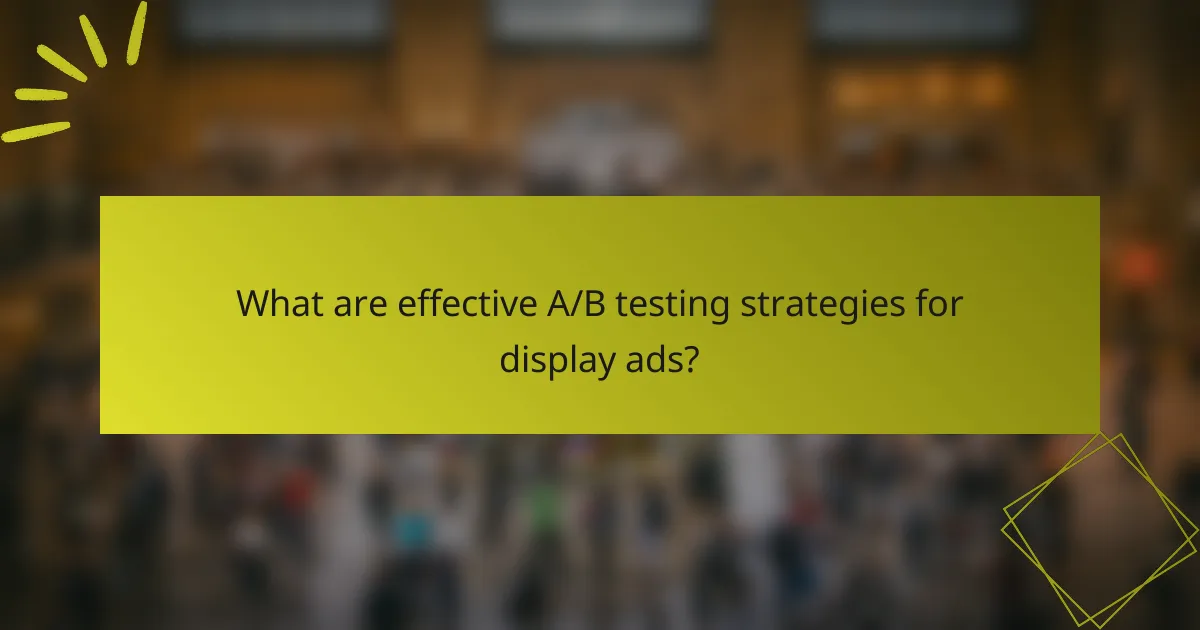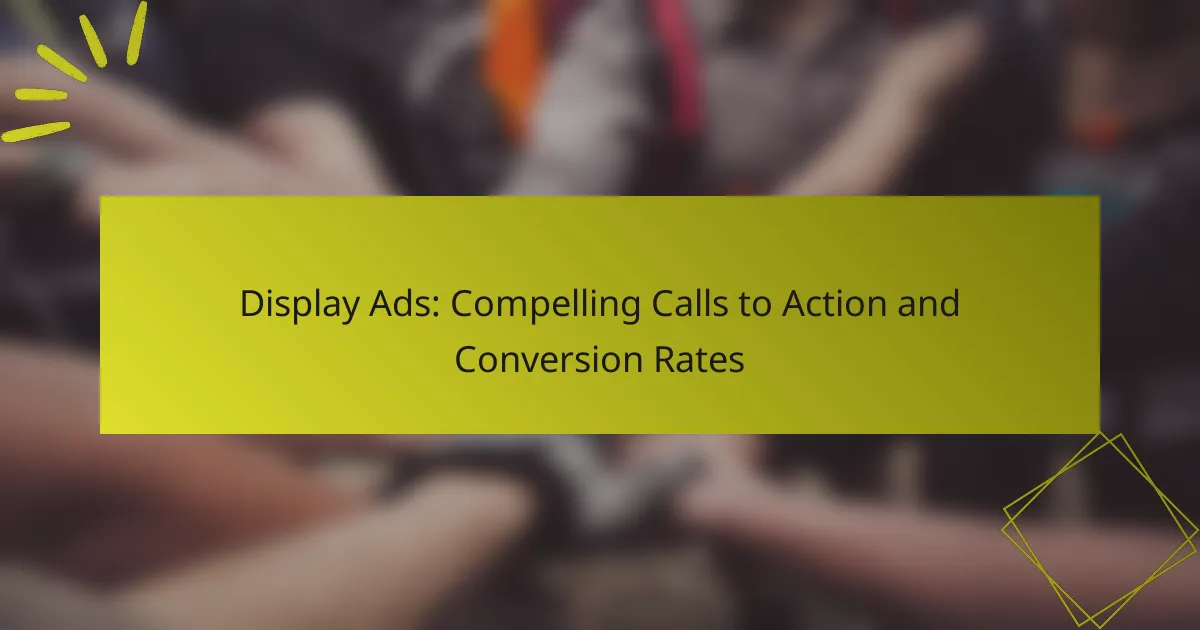A/B testing is a powerful tool for enhancing ad creative performance by allowing marketers to compare various ad versions and identify which ones resonate most with their audience. By systematically testing elements such as headlines, visuals, and call-to-action placements, marketers can optimize their ads for better engagement and performance. Tracking key metrics like click-through rates and conversion rates is essential for evaluating the effectiveness of these ad creatives and maximizing return on investment.

How can A/B testing improve ad creative performance?
A/B testing enhances ad creative performance by allowing marketers to compare different versions of ads to determine which resonates better with the target audience. This data-driven approach helps optimize ad elements, leading to improved effectiveness and higher returns on investment.
Increased click-through rates
A/B testing can significantly boost click-through rates (CTR) by identifying which ad variations attract more clicks. By testing different headlines, images, or calls to action, marketers can pinpoint the elements that drive user interest. For instance, a simple change in wording from “Buy Now” to “Get Yours Today” may yield a noticeable increase in CTR.
To maximize CTR, focus on testing one variable at a time, ensuring that results are attributable to the specific change made. Aim for a sample size that provides statistically significant results, typically in the low hundreds or thousands, depending on your audience size.
Enhanced user engagement
Through A/B testing, marketers can enhance user engagement by discovering which ad creatives prompt more interaction. Engaging ads often include compelling visuals and relatable messaging that resonate with the audience’s interests. For example, using vibrant images or relatable scenarios can lead to higher engagement rates.
Consider testing different formats, such as video versus static images, to see which garners more attention. Engagement metrics like time spent on the ad or social shares can provide valuable insights into user preferences.
Optimized conversion rates
A/B testing is crucial for optimizing conversion rates by allowing marketers to refine their ad creatives based on actual user behavior. By analyzing which ad versions lead to more conversions, businesses can make informed decisions about their advertising strategies. For example, testing different landing pages linked to ads can reveal which designs convert visitors into customers more effectively.
To improve conversion rates, ensure that your ads align closely with the landing pages they direct users to. Consistency in messaging and design can significantly enhance user trust and increase the likelihood of conversion. Regularly revisit and test your creatives to adapt to changing audience preferences and market trends.

What are effective A/B testing strategies for display ads?
Effective A/B testing strategies for display ads involve systematically comparing different elements to determine which variations yield better engagement and performance. Key strategies include testing headlines, visuals, and call-to-action placements to optimize ad effectiveness.
Split testing different headlines
Split testing different headlines is crucial as headlines significantly impact click-through rates. Test variations that differ in tone, length, or value proposition to see which resonates more with your audience.
For example, you might compare a straightforward headline like “Save 20% Today!” against a more emotional appeal such as “Unlock Your Savings Now!” Track performance metrics to identify which headline drives more clicks and conversions.
Testing visuals and color schemes
Visual elements and color schemes play a vital role in capturing attention and conveying brand identity. Experiment with different images, graphics, and color combinations to find the most appealing design for your target demographic.
Consider using contrasting colors for buttons and backgrounds to enhance visibility. For instance, if your primary color is blue, test variations with orange or green accents to see which combination leads to higher engagement rates.
Evaluating call-to-action placements
Call-to-action (CTA) placements can significantly influence user behavior. Test different positions, such as placing the CTA at the top, middle, or bottom of the ad, to determine where it performs best.
Additionally, experiment with CTA wording and size. A larger button with a phrase like “Get Started Now” may perform better than a smaller one saying “Learn More.” Monitor the results to optimize your ad’s effectiveness based on user interactions.

What metrics should be tracked in A/B testing?
Tracking the right metrics in A/B testing is crucial for evaluating the effectiveness of different ad creatives. Key metrics include click-through rate, conversion rate, and engagement time, each providing insights into user behavior and campaign performance.
Click-through rate (CTR)
Click-through rate (CTR) measures the percentage of users who click on an ad after seeing it. A higher CTR indicates that the ad is compelling and relevant to the audience. Aim for a CTR of at least 2-5% for digital ads, but this can vary based on industry and platform.
To improve CTR, consider testing different headlines, images, and calls to action. Avoid cluttered designs that may distract users and focus on clear, concise messaging that resonates with your target audience.
Conversion rate
Conversion rate reflects the percentage of users who complete a desired action, such as making a purchase or signing up for a newsletter. A good conversion rate typically ranges from 1-5%, depending on the industry and the specific goals of the campaign.
To enhance conversion rates, ensure that the landing page aligns with the ad’s message and provides a seamless user experience. Test various elements like form length, button color, and promotional offers to identify what drives the most conversions.
Engagement time
Engagement time measures how long users interact with your ad or landing page. Longer engagement times often suggest that users find the content valuable and are more likely to convert. Aim for engagement times that exceed 30 seconds for ads that direct users to a landing page.
To increase engagement time, create high-quality, informative content that addresses user needs. Use videos, infographics, or interactive elements to keep users interested and encourage them to explore further.

How to set up an A/B test for ad creatives?
Setting up an A/B test for ad creatives involves comparing two or more variations of an ad to determine which performs better. This process helps optimize engagement and conversion rates by providing data-driven insights into audience preferences.
Define your hypothesis
Start by clearly stating what you expect to learn from the A/B test. A hypothesis might be that a specific image will yield higher click-through rates than another. Ensure your hypothesis is measurable and directly related to your ad creatives.
For example, you might hypothesize that using a bright color scheme will increase engagement compared to a muted palette. This clarity will guide your testing process and help you interpret results effectively.
Select your audience
Choosing the right audience is crucial for accurate A/B testing results. Segment your audience based on demographics, interests, or behaviors to ensure that the test reflects your target market. This can help you understand how different groups respond to various ad creatives.
For instance, if you are running ads for a new fitness product, you might want to target health-conscious individuals aged 18-35. This focused approach increases the likelihood of obtaining relevant data that can inform your marketing strategy.
Determine sample size
Deciding on an appropriate sample size is essential for the reliability of your A/B test results. A larger sample size generally leads to more accurate conclusions, reducing the margin of error. Aim for a sample that is statistically significant, often in the low thousands, depending on your audience size.
As a rule of thumb, ensure that each variation receives a similar number of impressions to maintain balance. For example, if you have a total audience of 10,000, consider testing with at least 1,000 impressions per ad variation to achieve meaningful insights.

What tools can facilitate A/B testing in display advertising?
Several tools can streamline A/B testing in display advertising, allowing marketers to compare different ad creatives efficiently. These platforms provide features for designing experiments, analyzing results, and optimizing campaigns based on performance data.
Google Optimize
Google Optimize is a user-friendly tool that integrates seamlessly with Google Analytics, making it ideal for those already using Google’s ecosystem. It allows marketers to create A/B tests, multivariate tests, and redirect tests to evaluate various ad creatives.
One key advantage is its visual editor, which enables users to modify website elements without needing extensive coding knowledge. Additionally, Google Optimize offers personalized experiences based on user behavior, enhancing engagement and conversion rates.
Optimizely
Optimizely is a robust platform designed for A/B testing and personalization, catering to both web and mobile applications. It provides advanced targeting options, allowing marketers to segment audiences based on demographics, behavior, or traffic sources.
With its easy-to-use interface, users can set up experiments quickly and analyze results in real-time. Optimizely also supports integrations with various analytics tools, ensuring comprehensive insights into ad performance and user engagement.
VWO
VWO (Visual Website Optimizer) is another powerful A/B testing tool that focuses on improving user experience and conversion rates. It offers features like heatmaps, session recordings, and surveys to gather qualitative data alongside A/B test results.
Marketers can create tests with a simple visual editor and track performance metrics effectively. VWO’s robust reporting capabilities help identify winning variations and inform future advertising strategies, making it a valuable asset for display advertising campaigns.

What are common pitfalls in A/B testing?
Common pitfalls in A/B testing can significantly skew results and lead to incorrect conclusions. Understanding these pitfalls helps ensure that tests yield reliable and actionable insights.
Insufficient sample size
Insufficient sample size is a frequent issue in A/B testing that can lead to unreliable results. When the number of participants is too low, the test may not capture the true behavior of the target audience, resulting in misleading data.
A good rule of thumb is to aim for a sample size that provides a confidence level of at least 95% with a margin of error of 5%. This typically requires hundreds or even thousands of participants, depending on the expected conversion rates.
To avoid this pitfall, use online calculators to determine the necessary sample size based on your current traffic and desired confidence level. Always ensure that your sample is representative of your overall audience to improve the validity of your findings.


